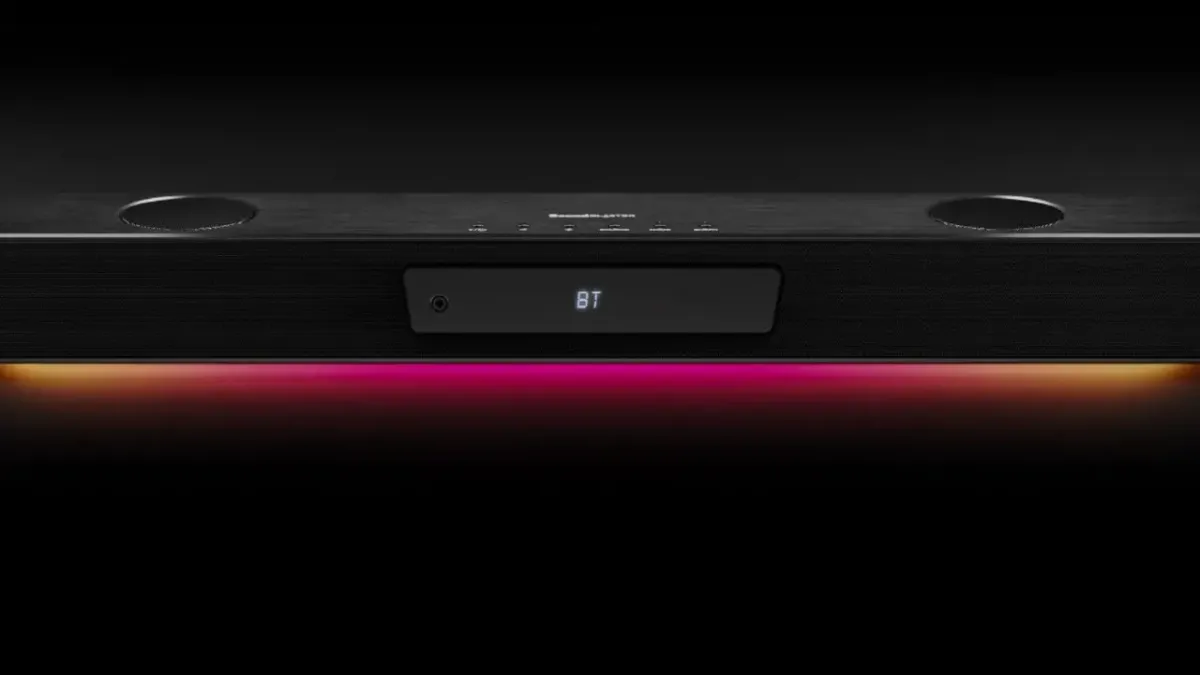
Don’t cite the deep magic to me, PC gamers, I was there when you had to edit your config.sys and autoexec.bat before you could play games. Back in the earliest days of PC gaming, when your sound card had to be configured with physical jumpers just to make it work, we also happened to be in a golden age of sound systems. You could get incredibly powerful systems in 5.1 and 7.1 surround sound configurations. There were a lot of companies making them, but the ones worth owning came from the literal inventors of PC soundboards – Sound Blaster. While most manufacturers have quit shipping anything larger than 2.1 systems, there are still a few willing to make premium sound systems. Not all of us want to game with headphones, so let’s unbox the Sound Blaster Katana V2, see what’s improved over its predecessor, and blow the doors off this thing.
As you can see above, there are only two devices in this box – a long soundbar, and a subwoofer. Joined by a handful of cables and a remote, this device is providing virtual 5.1 surround sound courtesy of two 63 mm (2.5”) mid-range drivers and two 19mm (¾”) fabric-covered tweeters. The multi-core DSP modules are applied individually on each of these, as well as the subwoofer, meaning there are a lot of possibilities for individual tuning (we’ll get to that in-depth a little later). The subwoofer is of the taller variety with a single 165mm (6.5”) subwoofer driver to bring the bass. If you can count without taking off your shoes to use your toes, you’ll probably conclude that this is only 4.1, technically. Getting it to 5.1 is accomplished via Creative Labs’ own proprietary digital signal processor. Dubbed the Super X-Fi (SXFI), this device is billed as Creative’s most powerful Sound Blaster chip, providing discreet processing for up to 8 channels of 24-bit 96 kHz audio. Built for their flagship headphones, this Super X-Fi tech brings simulated high-end multi-speaker sound to life in something the team is calling “Holographic Audio”. Effectively, they are purporting that it’ll be not unlike being surrounded by physical speakers, and with the same fidelity. How that’s accomplished is a bit of a surprise.
Measuring audio fidelity is a very, VERY subjective thing. The human ear is as unique as a snowflake, with every one of us having a different shape, canal length, eardrum angle of deflection, etc. As such, the way every person perceives sound is different, meaning I may hear a bunch of bass, but you might hear less due to the way your ears sit on your head. Similarly, open backed headphones vs. closed ones makes a difference, as does placement on the head, and how well they seal to the area around your ears. There are machines that cost tens of thousands of dollars to measure this (here’s a quick look at Head and Torso Simulator, or HATS, if you want a crash course in audio testing) to give you a scientific graph-based look at how headphones interact with a human head, but if you don’t have that, Sound Blaster is trying to give you the next best thing.

Downloading the Super X-Fi (SXFI) app on your phone or tablet, you’ll be asked to take a picture of your left ear, your entire head from the front, and your right ear. The app then creates a wireframe diagram of your dome, using AI at Sound Blaster HQ to create a virtual map. You’ll then select which headphones you want to use, including those of Sound Blaster’s competitors surprisingly enough, and it’ll do its best to provide you with truly immersive virtual surround sound. Frankly, I’m surprised at just how well it works – this could have been a gimmick, but I can honestly say I hear a difference with Super X-Fi enabled.
Creative Labs was aiming for a compact but powerful chassis, and they did reasonably well with the device’s predecessor – the Katana. Fans like myself felt like it could have used a bit more oomph, and the engineers heard you. The Katana V2 went from a 133mm subwoofer to a 166mm one, and that extra 33mm makes a huge difference.
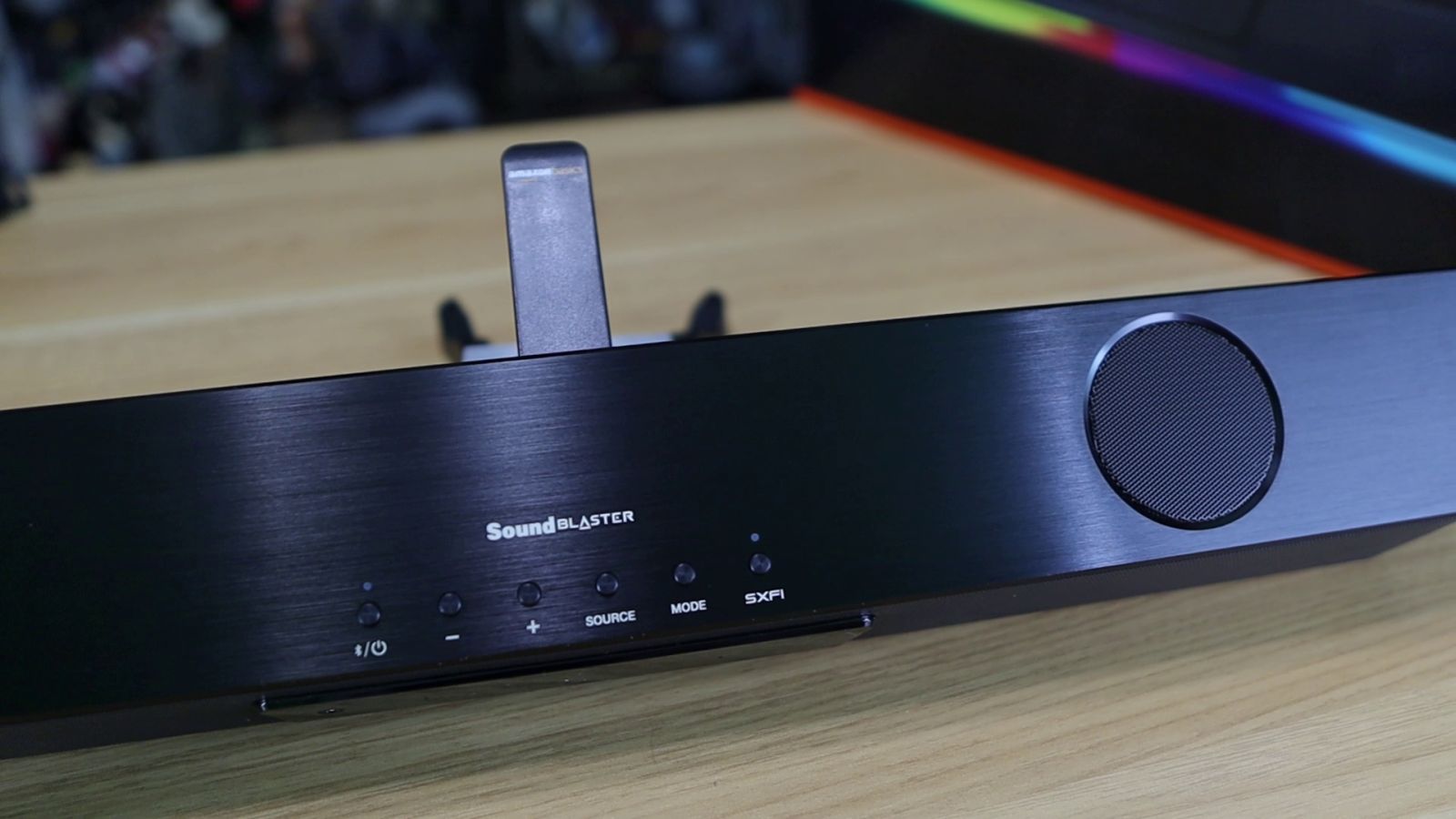
The Katana V2 includes a remote, which you may or may not find a use for in your setup. If you are running on PC or via Bluetooth you can control the device directly, but on console you may want to adjust the bar with the remote. The included remote does that, as you’d expect, but it also has six buttons that can be programmed to do whatever you’d like. If it can be controlled via infrared, such as lighting or turning on your TV, the world is your oyster.
If you are the type that likes to tinker with the software, the Creative Labs app is surprisingly well done. The first time you launch the app it’ll search for any Creative devices it can manage. It does this via Bluetooth, so make sure that’s turned on. One thing I really liked about the app is the “Can’t find device?” button which leads to a long list of supported products, as well as precise instructions on how to enable Bluetooth pairing on each one. This is something I normally have to scrape the Internet to find, so it’s great that Creative included it here directly.

Once in the app with your device detected, you’ll select said device (from a list if you have more than one) and be greeted with a wide variety of options. At the top is an option that says “Speakers” which lets you toggle to an attached pair of headphones for management, and “Bluetooth” which allows you to switch to the aforementioned input choices should you wish. Below these two choices lie 10 larger buttons for additional adjustment. Granted, none of this is required per se, but it does provide a far more granular control over the sound for the Katana V2, so it’s worth at least taking a look.
The first option is simply entitled “Sound Mode”, and within it is the tuning for the Acoustic Engine technology. Within this you can tune four general settings – Surround, Crystalizer, Smart Volume, and Dialog+. Each of these equalizer-like sliders are simple up and down notches, so you’ll have to adjust and listen as you go to find the sound that works for you. Crystalizer probably needs some explanation – it’s meant to enhance the range of compressed audio. Despite lossless codecs being a frequently-used thing, there are still plenty of apps and games that use compressed audio, so this is a welcome addition. In practice it’s hard to describe, but if pressed I’d have to call it a “warmer” and more whole sound. Smart Volume is a welcome feature, though one that works without you noticing if it does it correctly. It manages the initial sound of things like incoming calls, shows that are improperly sound balanced, etc. It helps prevent the massive blast of sound you otherwise get, and you should turn it on and realize the benefits as it’s off by default. Dialog+ is Sound Blaster’s tech to detect voice audio and attempt to push that forward in the sound envelope. In TV shows that’s character audio, and in songs that’d be lyrics. It’s a trick you can pull in the equalizer on your own, but here it’s done in an automated fashion. It’s off by default as well, but it’s a throw of the dice whether you’ll like that mod or not.
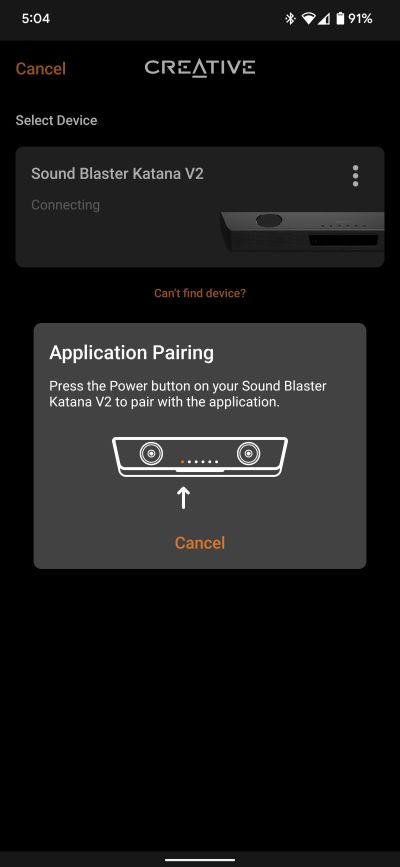
Below these options lie the EQ Presets. Split by genres like Gaming, Music, Movies and a few more archetypes, it then divides into music genres like Hip Hop, Pop, R&B, etc. Do yourself a favor and keep scrolling down – it’s here that you’ll find a surprise. Roughly two dozen of the most popular games on the market are represented here, including Cyberpunk 2077, Fortnite, Genshin Impact, Red Dead Redemption 2, and The Witcher 3: Wild Hunt. Others are grouped together like the Call of Duty series, or into bigger archetypes like Real Time Strategy, MOBA, or FPS. Once again, you could make your own versions of these same tweaks, but here it’s single-click applied.
The last two options are Lighting and Decoder. Lighting lets you adjust the rainbow colored bar that lies underneath the bar (you can see that in our video), allowing it to cycle through nine different presets, as well as turning it off.
The Decoder section has three options – Normal, Full, and Night, which are fairly unhelpful names to explain what they do. Normal is, as the name suggests, the full sound with a light touch of normalization to smooth any sharp sound spikes or bass thumps. Night is going to further reduce the loudness of the peaks and valleys so loud sounds are effectively the same volume as everything else – perfect for evening gaming when those spikes might wake people up. Full gives you the full dynamic range – peaks, valleys, all of it, without normalization. It’s set on normal by default, but audio purists might want to flip this to Full.
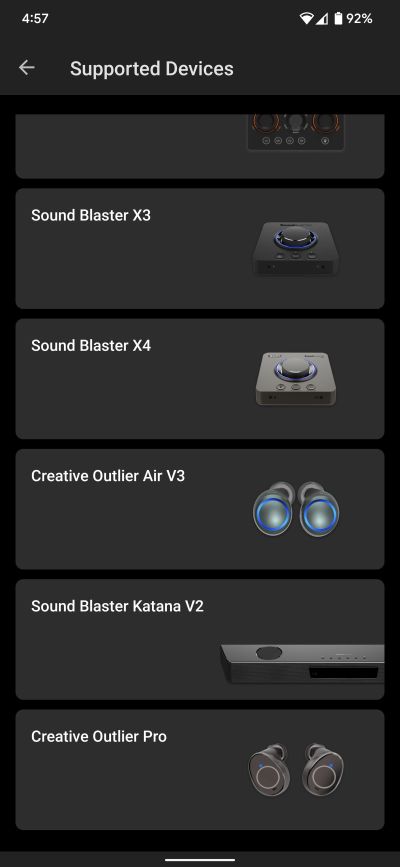
SXFI is a proprietary tech that helps the device approximate surround sound without requiring extra speakers. Heading into this section of the app, you’ll need to pair the SXFI app with your device, and ultimately activate it for the Creative Labs app. I hate having to use two apps to accomplish the same thing, but it’s a minor nitpick. Once paired, the device will go through an optimization process, providing the same advanced equalizing and simulated surround sound for a connected pair of headphones. Scout mode in SXFI focuses on helping you hear subtle movement sounds, reloads, and other audio queues for genres like stealth. Battle Mode on the other hand makes everything sound like a Michael Bay flick, with booming explosions and crushing bass, but also clear directionality. If the game’s audio supports it, you’ll hear the bullet’s source, just like you would on a high-end surround sound setup. It’s amazing to me that this tech can be passed through non-Sound Blaster attached gear, but it’s great to hear as it makes the Katana V2 the central hub of your audio.
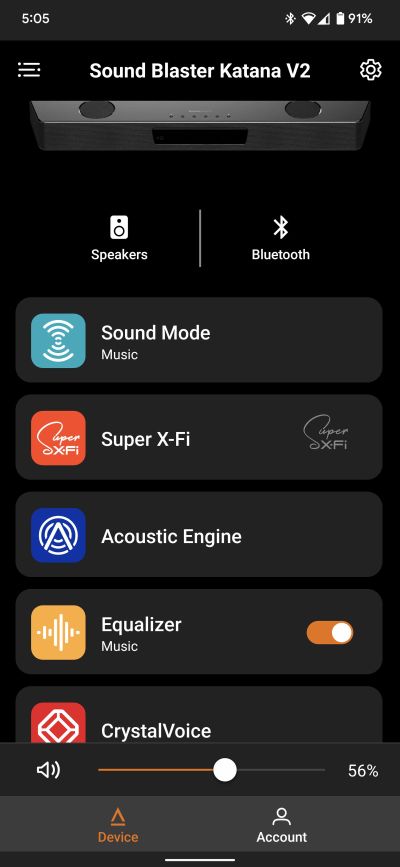
The last bit of buttons is labeled “Custom Buttons” and I’ll give you five guesses what that does. Inside you’ll find mapping for all of the buttons on the included remote, allowing you to quickly address functions like turning on the microphone, toggling the SXFI mode, change the input and output, adjust the aforementioned sound modes, or even bump up the bass. The mode button lets you cycle the modes (duh) but you can also map precisely which modes you’d like it to cycle through. Similarly, the RGB Light button allows you to map precisely which options to toggle.
I’m surprised to see this many options in any sound device. Firmware updates can be applied, meaning we’ll likely see these options expand, but if something went sideways you can even roll back to a “repair” state, likely meaning a safe firmware. That’s an option you have to seek out on a motherboard, so it’s great to see Sound Blaster include it. Best of all, if you want a simple experience, it’s all rather nicely tuned out of the box, so you could skip it entirely if you didn’t want to fuss with it.

Speaking of not wanting to fuss with things, I don’t need extra remotes in my life. I’m glad to say I was able to easily capture all of the functions in my Harmony remote, meaning I can use the same device that I control everything else to control the Katana.
The price on the Sound Blaster Katana V2 might give you a little sticker shock, MSRP on the device is $329, but hear me out. I have owned more than a few 5.1 audio setups for my PC over the years, and every one of them was easily that price or higher. Similarly, just the receiver on a full audio setup will set you back at least 75% of that price, with higher end ones sailing well past a grand. Price per feature, the Katana V2 delivers in a big way, and more importantly, it’ll do so for everything you run through it. Television, games, Blu-Ray movies, and more will all sound better. Will it replace a full 5.1 speaker set? No, but for any use case other than that, it’s absolutely astounding and worth every penny. Like a good monitor, good sound is worth investing in – that rising tide raises all boats.
Sound Blaster Katana V2 Sound Bar
Excellent
A premium device with premium features, but capable of raising your audio game at every level. It’s astounding what Creative Labs has accomplished in such a small package – you won’t believe your ears.
Pros
- Strong and clear at any frequency
- Multicore DSP allows a lot of individual adjustments
- A wealth of connectivity options
- Personalized audio with head/ear anthropometry
- RGB underglow is slick
- Too feature rich to list here…
Cons
- Some light sticker shock
